
The Central Pacific Railroad (CPRR) was a rail company chartered by U.S. Congress in 1862 to build a railroad eastwards from Sacramento, California, to complete most of the western part of the "First transcontinental railroad" in North America. Incorporated in 1861, CPRR ceased independent operations in 1875 when the railroad was leased to the Southern Pacific Railroad. Its assets were formally merged into Southern Pacific in 1959.

America's first transcontinental railroad was a 1,911-mile (3,075 km) continuous railroad line built between 1863 and 1869 that connected the existing eastern U.S. rail network at Council Bluffs, Iowa, with the Pacific coast at the Oakland Long Wharf on San Francisco Bay. The rail line was built by three private companies over public lands provided by extensive U.S. land grants. Building was financed by both state and U.S. government subsidy bonds as well as by company-issued mortgage bonds. The Western Pacific Railroad Company built 132 miles (212 km) of track from the road's western terminus at Alameda/Oakland to Sacramento, California. The Central Pacific Railroad Company of California (CPRR) constructed 690 miles (1,110 km) east from Sacramento to Promontory Summit, Utah Territory. The Union Pacific Railroad (UPRR) built 1,085 miles (1,746 km) from the road's eastern terminus at the Missouri River settlements of Council Bluffs and Omaha, Nebraska, westward to Promontory Summit.

The Union Pacific Railroad is a Class I freight-hauling railroad that operates 8,300 locomotives over 32,200 miles (51,800 km) routes in 23 U.S. states west of Chicago and New Orleans. Union Pacific is the second largest railroad in the United States after BNSF, with which it shares a duopoly on transcontinental freight rail lines in the Western, Midwestern and West South Central United States.

Promontory is an area of high ground in Box Elder County, Utah, United States, 32 mi (51 km) west of Brigham City and 66 mi (106 km) northwest of Salt Lake City. Rising to an elevation of 4,902 feet (1,494 m) above sea level, it lies to the north of the Promontory Mountains and the Great Salt Lake. It is notable as the location of Promontory Summit, where the First transcontinental railroad from Sacramento to Omaha in the United States was officially completed on May 10, 1869. The location is sometimes confused with Promontory Point, a location further south along the southern tip of the Promontory Mountains. Both locations are significant to the Overland Route: Promontory Summit was where the original, now abandoned, alignment crossed just north of the Promontory Mountains; while Promontory Point is where the modern alignment, called the Lucin Cutoff, crosses the southern tip of the Promontory Mountains.

The golden spike is the ceremonial 17.6-karat gold final spike driven by Leland Stanford to join the rails of the first transcontinental railroad across the United States connecting the Central Pacific Railroad from Sacramento and the Union Pacific Railroad from Omaha on May 10, 1869, at Promontory Summit, Utah Territory. The term last spike has been used to refer to one driven at the usually ceremonial completion of any new railroad construction projects, particularly those in which construction is undertaken from two disparate origins towards a common meeting point. The spike is now displayed in the Cantor Arts Center at Stanford University.
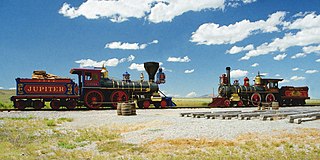
Golden Spike National Historical Park is a United States National Historical Park located at Promontory Summit, north of the Great Salt Lake in east-central Box Elder County, Utah, United States. The nearest city is Corinne, approximately 23 miles (37 km) east-southeast of the site.

The Omaha Zoo Railroad (OZRR) is the name of a 2 ft 6 in narrow-gauge heritage railroad located in the Henry Doorly Zoo & Aquarium in Omaha, Nebraska. The railroad offers a narrow gauge excursion train for zoo visitors hauled by a steam locomotive. The train loads passengers at two stations within the zoo. Annual ridership of the Omaha Zoo Railroad is over 200,000 people.

Union Pacific is a 1939 American Western drama directed by Cecil B. DeMille and starring Barbara Stanwyck, Joel McCrea and Robert Preston. Based on the 1936 novel Trouble Shooter by Western fiction author Ernest Haycox, the film is about the building of the eponymous railroad across the American West. Haycox based his novel upon the experiences of civil engineer Charles H. Sharman, who worked on the railroad from its start in Omaha, Nebraska in 1866 until the golden spike ceremony on May 10, 1869 to commemorate the joining of the Central Pacific and Union Pacific railroads at Promontory Summit, Utah Territory. The film recreates the event using the same 1869 golden spike, on loan from Stanford University.
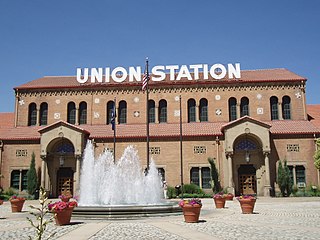
Union Station, also known as Ogden Union Station, is a train station in Ogden, Utah, United States, at the west end of Historic 25th Street, just south of the Ogden Central Station. Formerly the junction of the Union Pacific(UP) and Central Pacific (CP) railroads, its name reflects the common appellation of train stations whose tracks and facilities are shared by railway companies.

The Nevada State Railroad Museum, located in Carson City, Nevada, preserves the railroad heritage of Nevada, including locomotives and cars of the famous Virginia and Truckee Railroad. Much of the museum equipment was obtained from various Hollywood studios, where they were used in movies and television. The museum is operated by the Nevada Department of Tourism and Cultural Affairs. Opened in 1980, it was originally named the Virginia & Truckee Railroad Museum, often shortened to V&T Railroad Museum, but was renamed the Nevada State Railroad Museum in 1985.

The Jupiter was a 4-4-0 steam locomotive owned by the Central Pacific Railroad. It made history when it joined the Union Pacific No. 119 at Promontory Summit, Utah, during the golden spike ceremony commemorating the completion of the first transcontinental railroad in 1869.
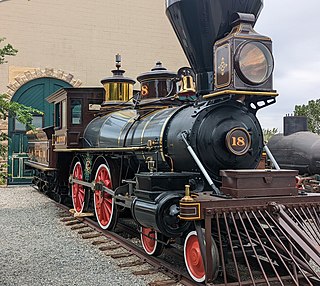
The Virginia and Truckee 18 Dayton is a historic standard gauge steam locomotive on display in Sacramento, California. It spent its working life on the Virginia and Truckee Railroad.

Chadwell O'Connor was an American inventor and steam engine enthusiast. He is most remembered as the inventor of an improved fluid-damped tripod head, for which he won Academy Awards in 1975 and 1992.

The Big Fill was an engineering project on the first transcontinental railroad in the U.S. state of Utah. To avoid a costly 800-foot (240 m) tunnel through mountainous terrain east of Promontory Summit, Central Pacific engineers mapped an alternate route that still needed to span the deep Spring Creek Ravine.
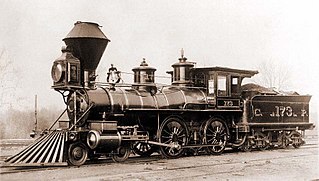
The Central Pacific Railroad number 173 was a 4-4-0 steam locomotive built by Norris-Lancaster for the Western Pacific Railroad in 1864. After its acquisition by Central Pacific, 173 was involved in a bad wreck, lying idle for two years before undergoing a sweeping reconstruction by the line's Sacramento Shops. It subsequently became the prototype for the railroad's engines when the CP began constructing locomotives. The engine was successful, and more engines were built to 173's design.
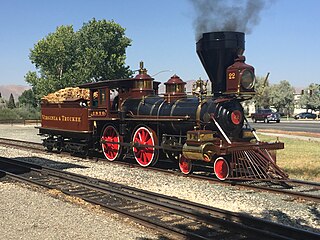
Virginia and Truckee Railroad No. 22, also known as the "Inyo", is a 4-4-0 "American" type steam locomotive that was built by the Baldwin Locomotive Works in 1875 and pulled both passenger and freight trains. The Inyo weighs 68,000 lb (31,000 kg). Its 57 in (140 cm) driving wheels deliver 11,920 lb (5,410 kg) of tractive force. In 1877 it was fitted with air brakes and in 1910 it was converted to burn oil rather than wood.
Gerald M. Best (1895–1985) was a noted railroad historian, writer, photographer, and one of the top sound engineers in the motion picture industry.

The history of the Union Pacific Railroad stretches from 1862 to the present. For operations of the current railroad, see Union Pacific Railroad; for the holding company that owns the current railroad, see Union Pacific Corporation.
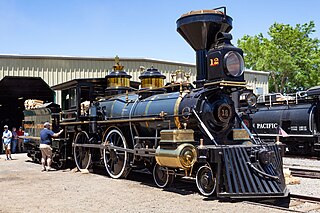
Virginia and Truckee Railroad No. 12, nicknamed Genoa, is a 4-4-0 American steam locomotive built by the Baldwin Locomotive Works in January 1873 for the Virginia and Truckee Railroad. She is one of three largely identical 4-4-0 locomotives built by Baldwin for the railroad, the others being the Reno and the Inyo, and one of four V&T 4-4-0's preserved.

The Leviathan, officially known as Central Pacific #63, was a 4-4-0 steam locomotive owned by the Central Pacific Railroad. It was notable for helping construct the First transcontinental railroad before hauling Leland Stanford's special train, which was then passed on to sister engine #60, the Jupiter, to take part in the railroad's completion in 1869.





















